Japanese gardens are one of Japan’s traditional cultures that have been passed down from the Asuka period to the present day. Japanese gardens have changed in form and meaning to reflect each era. However, the reason they are so highly praised around the world is probably because they reflect the deep thoughtfulness of the Japanese people.
One of the characteristics of Japanese gardens is that they are natural landscape-style gardens. In other words, they incorporate natural scenery into the garden. However, they are not simply images of natural scenery. What is important is that there are arbitrary elements. Arbitrary means that the wishes and hopes of the owner and creator are incorporated into the garden design. That is why the ideas of the time are directly reflected in Japanese garden design.
Japanese gardens have many designs that were created with the hope of becoming better because of these arbitrary elements. For example, the Pure Land-style garden, which emerged at the end of the Heian period when the world was in turmoil, placing hope in the Buddhist world. The pond-and-stream-style garden, which incorporated the Taoist philosophy from the continent during the Warring States period, wishing for victory and prosperity, featuring islands like Penglai Island, Crane Island, and Turtle Island. In this way, Japanese gardens have passed down numerous designs that reflect the auspicious beliefs of the Japanese people who shaped the era, into modern garden techniques.
Additionally, the Izumo region of Shimane Prefecture boasts the uniquely developed Izumo-style garden. In this article, we will introduce an example of a Japanese garden based on the Izumo-style garden, constructed at a private residence in Izumo City, Shimane Prefecture, which embodies auspicious elements.
1. Designing auspicious Japanese gardens
First, we will design a Japanese garden that brings good luck. Your request this time is for a Japanese garden with stones and a portion that can be used as a field.
Japanese gardens, regardless of size, are basically designed as a collection of individual points. For example, there are sections where stones are arranged to resemble mountains or waterfalls, and islands shaped like turtles. These individual focal points are combined to form the overall design. Therefore, we first assess the size of the site and the amount of materials available to determine how many focal points to incorporate. These focal points are essentially the highlights of the garden.
In this case, we will incorporate seven such focal points. The diagram below shows the overall layout. We will now explain each focal point alongside photos of the completed garden.
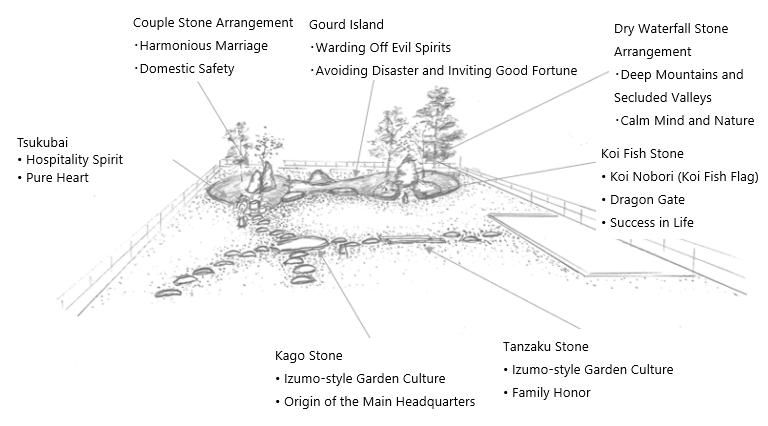
2. Kare-taki stone arrangement and koi fish stone
The standing stone on the far right side is designed to resemble a waterfall without using water. The direction is southwest. In terms of feng shui, this is the direction of the rear demon gate, which is an important location.
In Izumo City, Shimane Prefecture, there is an Izumo-style garden that has developed in a way that is rare even on a national scale. In Izumo-style gardens, a large standing stone is always placed in the rear demon gate direction. With this regional garden style in mind, a waterfall stone arrangement using standing stones has been installed in this direction. This standing stone is the largest stone in the garden.
The waterfall stone arrangement consists of the standing stone and the stones on either side, which together form a waterfall basin. The water falling into the pool flows outwards toward the vast sea in front. A small standing stone can be seen in the pool. This stone represents a carp attempting to climb the waterfall and is called a “carp stone” (ryogyo-seki). The combination of the waterfall stone arrangement and the carp stone holds a very auspicious meaning.
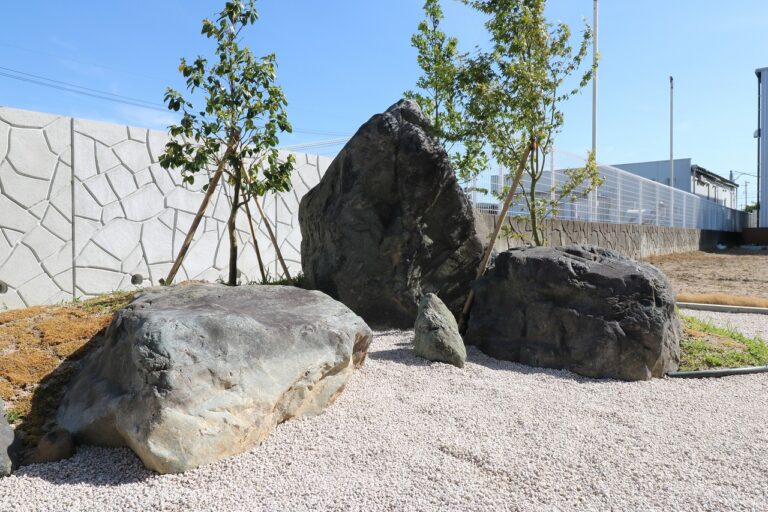
Let’s take a look at the meaning of koi fish stones. In China, there is a rapid called Longmen in the upper reaches of the Yellow River, where many koi fish gather, but most of them are unable to swim upstream. However, there is a proverb that says that if a koi fish manages to swim upstream, it will become a dragon, and this proverb has also been passed down in Japan. This difficult challenge, which promises success, is called the Dragon Gate. As a result, carp streamers were erected to wish for the growth and success of boys. Additionally, the carp’s ascent up the waterfall was adopted as a technique in Japanese gardens during the Kamakura period, and the carp stones in the gardens of Kinkaku-ji Temple and Tenryu-ji Temple are famous.
The plantings on the right side of the dry waterfall stone arrangement are Japanese maple trees. Compared to mountain maple trees, Japanese maple trees have smaller leaves and have been popular garden trees for a long time. There is a reason why they are planted alongside the waterfall stone arrangement. The idea is that as the branches grow, they will eventually hide the standing stones, creating an image of being touched by the spray of the flowing water. Such trees are referred to as “fisen swarari no ki” (flying waterfall screen trees) in the Edo-period text “Chikusen Tei Zōden,” which describes techniques for beautifying gardens. Therefore, in future garden maintenance, the branches of the maple trees will be pruned to extend toward the standing stones, eventually allowing them to appear and disappear intermittently.
The technique of the “flying waterfall screen tree” involves not revealing the waterfall but allowing it to appear and disappear, thereby enhancing the ambiance of a deep mountain waterfall. The photo below shows the waterfall at the old Koga Garden, where the maple trees are naturally managed to cover the waterfall as a “Flying Waterfall Screen.” Of course, this did not happen by chance; it was achieved through pruning and management. The art of pruning lies in making it appear as though nothing has been done, which is also a key to the beauty of Japanese gardens.
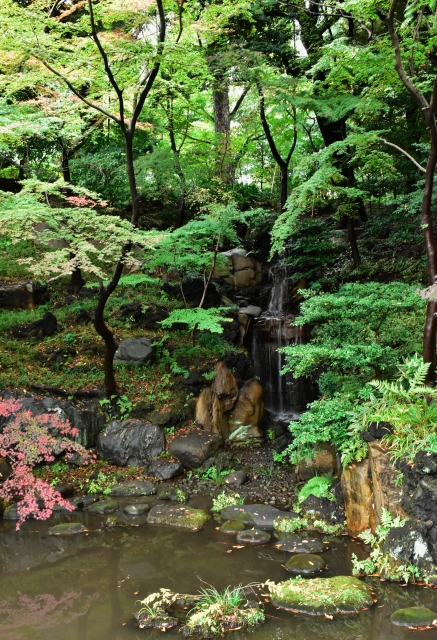
3. husband and wife stones
The two stones of different sizes arranged together in the back left represent the harmony between husband and wife, known as a “husband and wife stone arrangement.” In Japanese garden stone arrangement techniques, there is a “ruler and subject stone” arrangement that combines two stones of different sizes to represent the ruler and subject. This signifies the close relationship between the ruler and subject. The Manpuku-ji Temple in Masuda City, Shimane Prefecture, which is famous nationwide as the Sesshu Garden, features a ruler and subject stone arrangement.
Similarly, the couple stone arrangement represents the harmonious relationship between a husband and wife. The standing stone on the right represents the husband, while the stone on the left represents the wife. Each stone leans toward the other, forming a unified whole. The stone colors and textures are carefully selected, and intentionally different stones are used to highlight the presence and meaning of the couple stones.
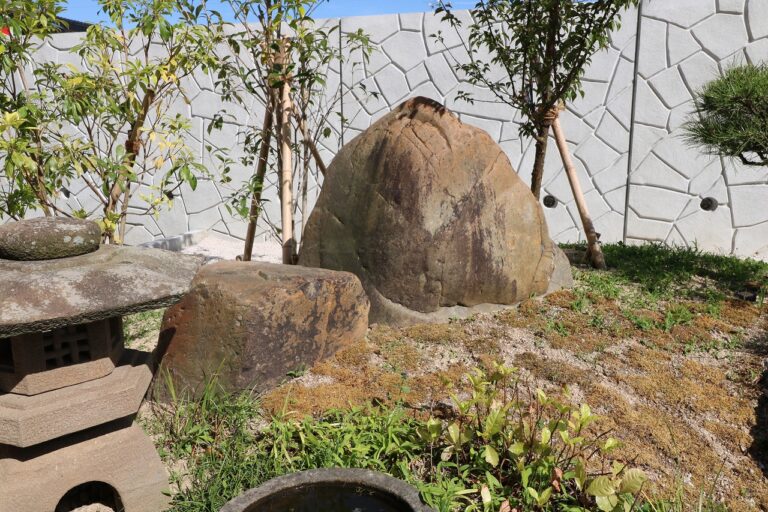
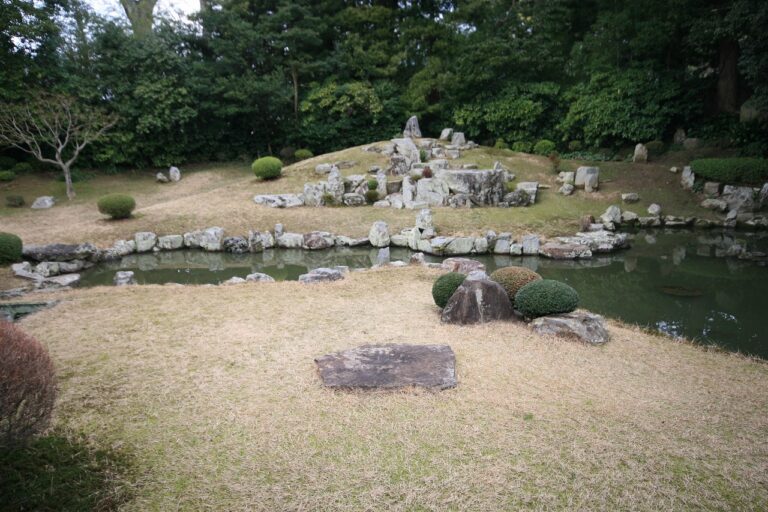
4.Tsukubai
From the Muromachi period to the Azuchi-Momoyama period, Sen no Rikyu, who perfected the wabi-sabi style of tea ceremony, devised the squatting basin as an essential feature of the tea garden, and it later became a symbol of the charming atmosphere of Japanese gardens. The squatting basin is used for washing hands, but the term “squatting basin” refers to the act of squatting with the body in a rounded position. In other words, a squatting basin is a facility used to lower one’s posture and scoop water to wash one’s hands. In martial arts such as kendo and sumo, the squatting posture is used as a final bow, and this refers to the same posture.
It would be more convenient to make the squatting basin larger so that one could wash their hands without forcing their posture to be low. However, there is a reason for keeping it low. This is because the squatting posture is one of the facilities used in the tea ceremony. In the tea ceremony, all guests are equal, and even a lord is treated equally. At the squatting posture installed on the way to the tea room, everyone lowers their backs, bows their heads, and washes their hands and mouths to purify themselves. Therefore, the squatting posture is designed to be used in a low posture.
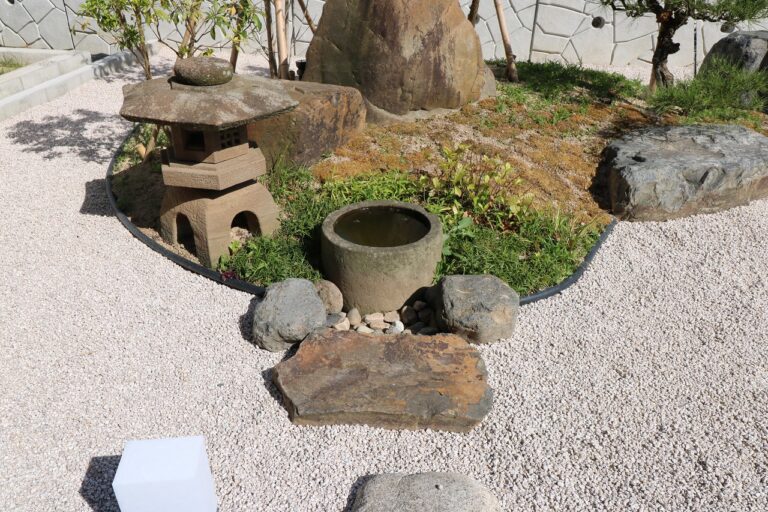
The basic components of a tsukubai include four functional stones: a water basin (chōzubachi) for holding water, a hot water stone (yuokeishi) on the right side, a hand candle stone (teshokuishi) on the left side, and a front stone (maeishi) at the front.
The water basin is a stone used to hold water, making it an indispensable component of the squatting stone. While many are made from natural stones that have been carved, in this case, we have used a stone mill made from Kurama stone, which is only found in the Kurama region of Shimane Prefecture’s Matsue City, Shimane Town. “Kurama stone” is a tuffaceous sandstone formed from volcanic deposits that accumulated on the seabed 14 million years ago (mid-Miocene epoch of the Neogene period) in the “Omoshiro-Kurama Formation” distributed along the southern shore of Lake Shinjiko (around the Kurama region of Shinjiko Town, Matsue City).
The yutou-ishi (hot water bucket stone) is used during winter tea ceremonies when the water in the water basin is too cold to use. The host places hot water in a bucket for the guests, and this stone is used to hold the bucket. Therefore, the top of the stone is flat.
The te-shaku-ishi (hand candle stone) is used during nighttime tea ceremonies when guests use hand candles, which are old-fashioned lamps, to illuminate their feet. It is a stone on which to place the hand candle when washing one’s hands in the squatting position. Therefore, the top of the hand candle stone is also flat.
The front stone is a stone for people to stand on. When the front stone and the center of the water hole in the water basin are placed about 70 cm apart, it becomes easier to scoop water while squatting.
The central stone is called the “sea,” and it prevents water from splashing back when it flows and hides the water when it accumulates. This is where the water drains, but a jar is buried under the sea to make the falling water resonate, creating a suikinkutsu (water stone).
To the left of the squatting position is a lantern. Lanterns were introduced from the continent along with Buddhism and were first adopted in shrines and temples, but after Sen no Rikyu adopted them for tea gardens, they began to be used in gardens as well. Especially for illuminating the squatting position, lanterns that are low in height and harmonize with the scenery of the squatting position are preferred, and many lanterns were designed by tea masters themselves. The lantern is intended to illuminate the center of the hand-washing basin, so it is oriented toward the water surface of the basin rather than the front stone. The lantern in this case is a hexagonal snow-viewing lantern made of Kuraishi stone.
The round stone visible in the foreground is part of the stepping stones. Since the squatting stone must be accessible by foot, it is connected by stepping stones.
As mentioned above, the tsukubai is typically placed in a tea garden. Therefore, it is usually paired with a tea room. However, in the Izumo-style garden, which developed uniquely in the Izumo region of Shimane Prefecture, the tsukubai is always placed regardless of the presence of a tea room. This is because Matsudaira Fumai, the seventh lord of Matsue Castle, was a famous daimyo tea master and is still popular as a hero in the Izumo region today.
5.Kagoishi and Tanazakishi
The Izumo region boasts a very rare garden culture, with thousands of gardens featuring the same layout, built during the Showa era. This group of gardens is known as the Izumo-style garden. Among the characteristics of the Izumo-style garden are the kago-ishi (pillow stones) and tan-saku-ishi (short rectangular stones).
The Izumo region of Shimane Prefecture was part of the Izumo Province of the Matsue Domain, which was ruled by the Matsue Castle lord during the Edo period. The Matsudaira family, the Matsue Castle lords, were relatives of Tokugawa Ieyasu and were treated as a branch family of the Tokugawa clan. The Matsue Castle lord traveled to Edo for the sankin-kotai system, but also visited Izumo Taisha Shrine as part of his travels. During these visits, he stayed at large mansions along the way, and it was a great honor for a mansion to be used as a lodging. The selected mansion was called the “Honjin,” a large merchant mansion capable of accommodating 70 retainers. To receive the lord, a special gate called the “Onarimon” had to be constructed. The lord entered through the O-narimon gate in a palanquin and immediately ascended to the study from the palanquin. At that time, a very large stone was placed to hold the palanquin. This stone, which served as a base for the palanquin, is called a “kago-ishi” (palanquin stone). Kago-ishi were also constructed during the Meiji period when large merchant houses were built across the country, and even in private homes during the Showa period.
The short-striped stone is similarly a design element that has been passed down from the main residence to private homes in the Showa era. The short-striped stone is a design element of the stepping stones, consisting of two long, rectangular stones placed side by side. Both the palanquin stone and the short-striped stone came to symbolize wealth and honor in the Meiji-era wealthy farmer’s residences, with larger stones indicating greater wealth and prestige.
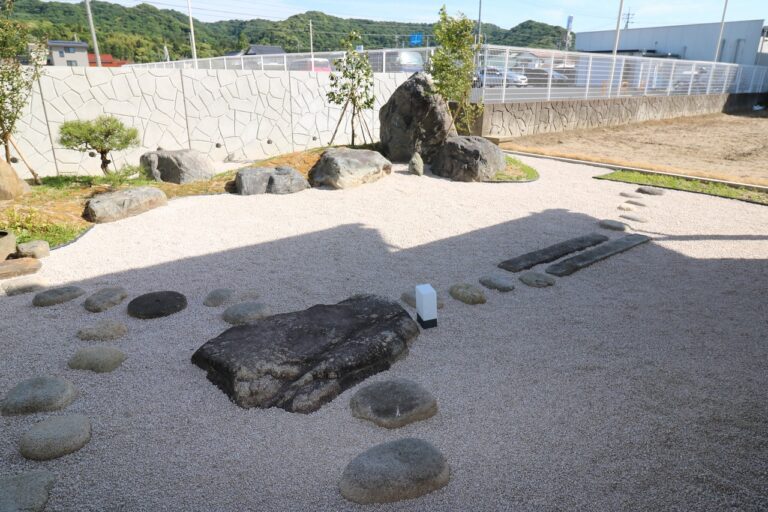
The large flat stone in the center is the kago-ishi. Following the stepping stones are two long stones called tanazuki-ishi. The kago-ishi, placed at the center of the garden, has a strong presence and also serves a scenic role in balancing the stepping stones laid out across the wide gravel area. The stepping stones also symbolize the path ahead, representing connections such as going to the squat toilet or lighting the lantern. In this case, the garden is connected to a vegetable garden. While it is customary in Izumo-style gardens to use flat natural river stones for stepping stones, incorporating stone mortars as decorative elements is a unique feature.
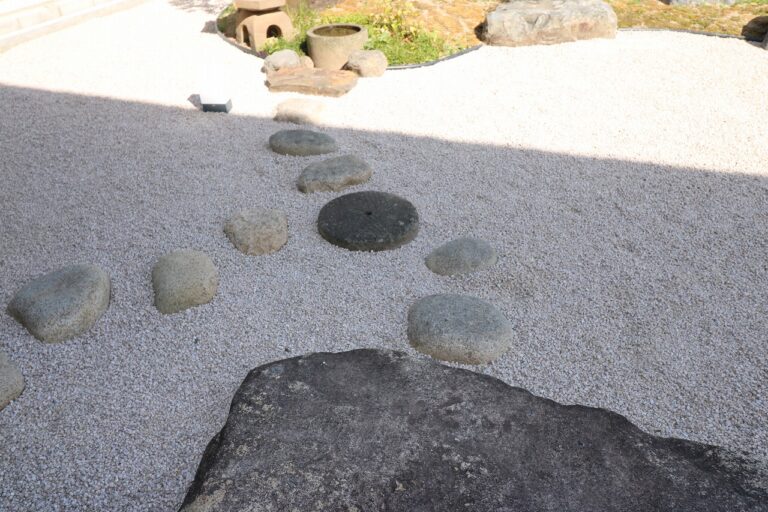
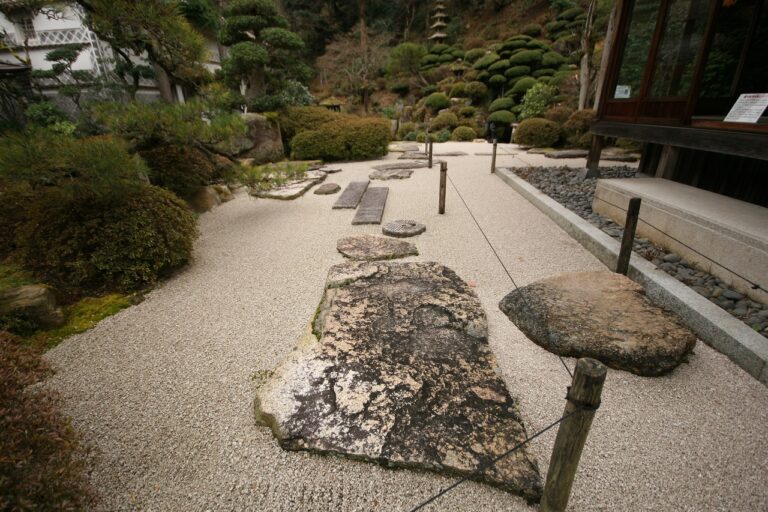
6.Gourd Island
Since ancient times, gourds have been considered to be inhabited by spirits and have been used as ritual implements. Their narrow necks are believed to trap evil spirits, while their flared shapes are considered auspicious and have been used as amulets and talismans. In addition, the way they grow in clusters has come to symbolize prosperity and the flourishing of descendants. Matsudaira Fumai, the seventh lord of Matsue Castle and a renowned tea master, frequently incorporated gourd shapes into his work, including his signature.
In this case, the mountainous area of the garden, which forms an island, is shaped like a gourd. It evokes the image of a gourd-shaped island. When viewed from above, it is clear that the left and right sides are rounded, while the center is indented. At the same time, the height of the artificial hill is higher on the left and right sides and lower in the center. The shape is reminiscent of a large gourd lying on its side, half buried in the ground.
Furthermore, while each point of the stone arrangement on the gourd island has been explained individually, the entire arrangement must also form a unified whole. By “unified,” we mean that the center of gravity must be stable. If the stones are biased toward the right side or the balance between the right and left sides is uneven, no matter how beautiful the individual points are, the overall impression will feel off-balance. The key to this is the stone on the other side of the center. In this stone arrangement, the dried waterfall stone arrangement on the right side has the strongest presence. Next are the married couple stones and the squatting stone on the left side. Thus, the center of gravity is distributed between both sides. Connecting these are the landscape stones at the base of the black pine tree placed in front of the central area and the landscape stones on the right-hand side of the retaining wall. Finally, the landscape stone placed at the back of the central area determines whether the overall composition appears stable or unstable, depending on its placement and height.
It becomes clear that Japanese gardens are a three-dimensional aesthetic creation that harmonizes the division of the land, the beauty of the focal points, and the overall balance.
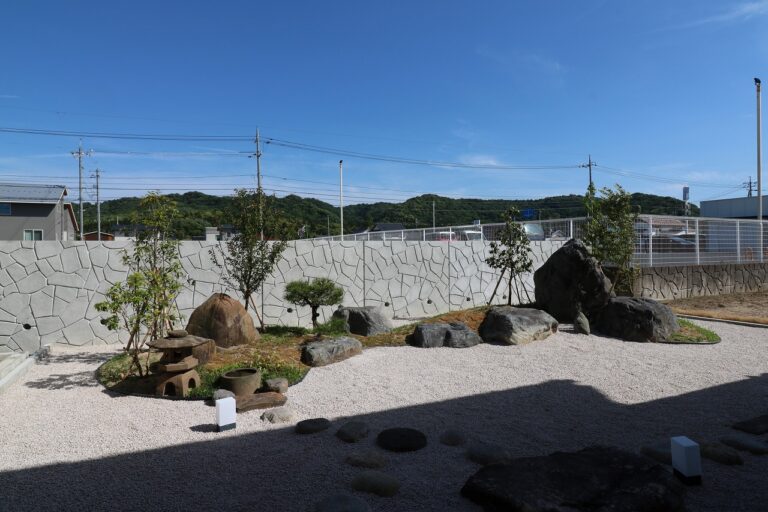
7.Summary
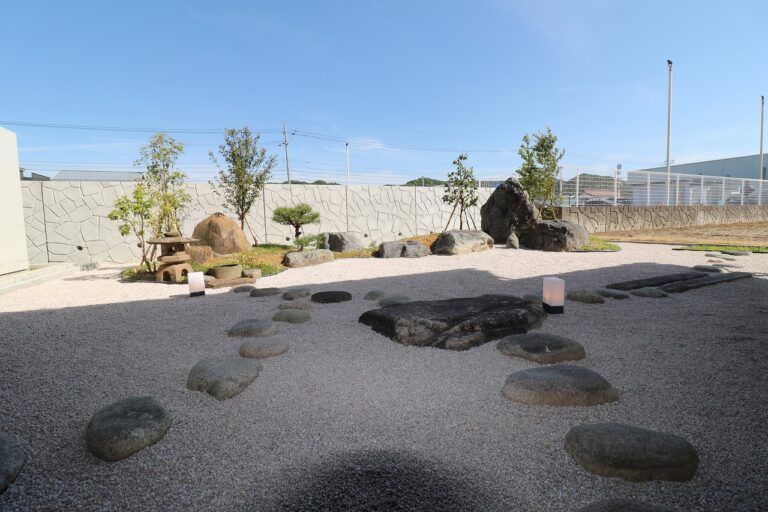
This garden is based on the Izumo style of Japanese gardens, which are considered auspicious, and we have explained it in detail. To summarize, here are the highlights and key points of the garden.
・Dry waterfall rock arrangement—a scene of deep mountains and secluded valleys, standing stones associated with Izumo style gardens
・Flying fountain screen tree—traditional landscaping techniques, Japanese maple
・Carp stone—the gateway to success, social advancement
・Couple stones – Good relationships, marital harmony, and household safety
・Squatting stone – The spirit of tea ceremony, the Japanese heart, and a stone associated with Lord Fumai
・Gourd island – Disaster prevention and good fortune, and many children
・Palanquin stone and short poem stone – Associated with the main headquarters
This is an auspicious Japanese garden that inherits the traditional culture of the region and embodies the Japanese spirit. Just as Shintoism, which values the sense of security that comes from believing that gods reside in all aspects of nature and that our lives can be lived safely by communicating our wishes to those gods, has been passed down, this garden is imbued with strong wishes.
Japanese gardens are microcosms of nature, yet they also contain arbitrary elements. This is why it is said to be the most beautiful in the world. These arbitrary elements are imbued with the wish for a better life. In other words, a Japanese garden is inherently a garden of good fortune. Understanding this meaning reveals the true value of a Japanese garden. The value of a Japanese garden lies not merely in its beauty, but in the unique existence of a place where wishes, hopes, and prayers are imbued.

